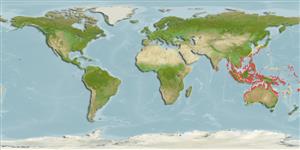Klassifizierung / Names
Namen | Synonyme | Catalog of Fishes(Gattung, Arten) | ITIS | CoL | WoRMS | Cloffa
>
Gobiiformes (Gobies) >
Gobiidae (Gobies) > Gobiinae
Etymology: Acentrogobius: Greek, a = without + Greek, kentron = sting + Latin gobius = gudgeon (Ref. 45335); moloanus: Named after its type locality, Molo, Iloilo, Panay I., Philippines..
More on author: Herre.
Environment: milieu / climate zone / depth range / distribution range
Ökologie
seewasser; brackwasser demersal. Tropical
Western Pacific: Ryukyu Islands, Philippines, Indonesia (Ref. 559) and Papua New Guinea (Ref. 6771). Occurs in the Mekong delta and probably ascends to the upper edge of the tidal zone in Cambodia (Ref. 12693).
Size / Gewicht / Alter
Maturity: Lm ? range ? - ? cm
Max length : 8.2 cm TL Männchen/unbestimmt; (Ref. 125282); max. veröff. Gewicht: 5.90 g (Ref. 125282)
Occurs along tidal rivers and along coastlines. Feeds on small fishes and invertebrates (Ref. 12693).
Life cycle and mating behavior
Geschlechtsreife | Fortpflanzung | Ablaichen | Eier | Fecundity | Larven
Rainboth, W.J., 1996. Fishes of the Cambodian Mekong. FAO species identification field guide for fishery purposes. FAO, Rome, 265 p. (Ref. 12693)
IUCN Rote Liste Status (Ref. 130435)
Bedrohung für Menschen
Harmless
Nutzung durch Menschen
Mehr Information
NamenSynonymeMetabolismusRäuberÖkotoxikologieFortpflanzungGeschlechtsreifeAblaichenSpawning aggregationFecundityEierEientwicklung
ReferenzenAquakulturAquakultur ProfilZuchtlinienGenetikElectrophoresesVererbbarkeitKrankheitenVerarbeitungNutrientsMass conversion
Tools
Zusatzinformationen
Download XML
Internet Quellen
Estimates based on models
Preferred temperature (Ref.
123201): 24.9 - 29.3, mean 28.6 °C (based on 2118 cells).
Phylogenetic diversity index (Ref.
82804): PD
50 = 0.5000 [Uniqueness, from 0.5 = low to 2.0 = high].
Bayesian length-weight: a=0.00676 (0.00350 - 0.01307), b=3.12 (2.96 - 3.28), in cm total length, based on LWR estimates for this species & Genus-body shape (Ref.
93245).
Trophic level (Ref.
69278): 4.2 ±0.73 se; based on food items.
Widerstandsfähigkeit (Ref.
120179): hoch, Verdopplung der Population dauert weniger als 15 Monate. (Preliminary K or Fecundity.).
Fishing Vulnerability (Ref.
59153): Low vulnerability (10 of 100).
